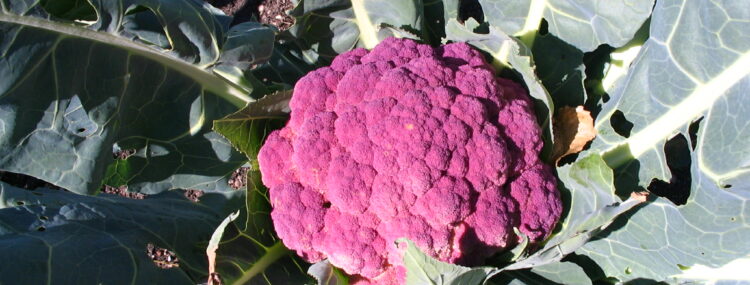
Cauliflower/Chard
Don’t know about you, but I happen to like tearing a stem of Chard straight from the plant and chewing on it when I am thirsty. Not only is it refreshing, but it will keep me going if I become quite hungry and I just want to “push through” on my garden jobs.
Will remain online for educational purposes. Operating on a “Hobby” basis.
Occasionally we may have “extra” seed. Pkts. marked below. If nothing marked…then it is “N/A”.
CAULIFLOWER:
- Brocoverde – (aka Romanesco) Just like in the store! A light green-headed, very sweet, variety…the result from a cross between a cauliflower and broccoli. Medium-sized, domed heads mature at 400g. secured on strong stems. Will tolerate some warm weather, but prefers (as all do in this family…) it cool. 70 days.
- Cheddar hyb. – (aka Citrus Orange “Johnny’s”) True orange colored curds that taste nutty, formed in medium-sized heads. High levels of beta-carotene, compared to all others. Plant early to take advantage of the cool weather growth and keep well-watered through out the growing season or these beautiful heads will decay quickly. Plants are unusually short compared to other cauliflower varieties, with their very top reaching only 12″! Heads however are quite large compared to overall plant growth. Matures in 68 days.
- Early Snowball – Introduced to N.A. by Peter Henderson & Co. in 1888. Still one of the most popular and highly prized vegetables. Produces beautiful, well-rounded, showy white heads with smooth curds. Very tender…not like some store bought types. Heads are produced very early at 60 to 80 days, reaching 6” to 7” in diameter.
- Purple Cape – Introduced from South Africa in 1808. Rich purple heads with excellent flavor. Winter-heading type, ready in late winter or early spring! Best planted in late winter or very early spring in a cold frame and over-wintered. Winter hardy in Zone 6! 200 days from transplants!
- Purple of Sicily – Beautiful brilliant purple heads weigh 2 to 3 lb and offer fine sweet flavor. Cooking causes the heads to change to a bright green! (So eat raw!) An insect resistant variety. I have found this variety far easier to grow than white varieties. Plants have no problem reaching heights of 4 to 5 feet! One of the last ones to mature, well into frosty conditions! Rich in minerals. Colorful and a pleasure to grow…easy! An Italian Heirloom. 95 days
- Violetta Italia – Quite similar to the above variety, only the shade will be more of a violet/burgundy color. Another “Fall” finisher. Beautiful! 95 days
CHARD:
- Bright Lites – the late New Zealand amateur plant breeder, John Eaton was said to have developed this variety and is now maintained for purity by Johnny’s of the US. Stems offer up many colors…gold, pink, orange, purple, red and white…with variations to darker and lighter pastels. Leaves are lightly scalloped green or bronze. It appears that the colored series are milder than the whites and said to be somewhat less frost hardy than the whites, too. (Can’t honestly say that this variety is very different than the 5-colored types, yet each maintains a different source of origin…) 60 days.
- Canary Yellow – They say chard originated in the Mediterranean region. Here is another stunning variety for the garden! A wonderful contrast to all others like the reds, oranges, pinks, whites and especially the emerald green of its leaves! Taste is great and a fine substitute for spinach in salads.
- Five Color Silverbeet – (aka Rainbow Chard) A beautiful colored variety…very brilliant pinks, reds, yellows, orange and white in various shades. Been told that the original variety was from Australia & thanks be… an Australian Digger’s Garden Club still maintains it! Thompson & Morgan called it Rainbow Chard, running it from 1970 to 1989. The SSE maintains this variety under strict isolation to keep the colors pure and strong. Flavors are again milder than some of the white varieties. Pretty enough to plant in the flower garden. 60 days
- Oriole Orange Chard – A stunning selection from an already brilliantly colored bunch! One of my personal favorite colors…Vibrant orange. (Just as an extra note: Young seedlings will appear as if the wrong seed has been sown, such as “Canary Yellow”. Do not worry, they will mature to the vibrant color as promised!) 60 days
- Perpetual Chard – a variety that has finer textured spinach-like leaves with smaller stems. Will continue to grow from the center with continued harvesting. Leaves stay tender right up till fall. Is more tolerant of heat than other varieties. Best for smaller gardens. 55 days
- Rhubarb Red Chard – (aka Ruby Red Chard) A strain refined by Dr. John Navazio for wider petioles. Introduced into gardens in 1857. Shows deep crimson (candy-apple red) stalks with dark green/red-veined contrasting, heavily crumpled leaves. Less pink types (mutations…) with greater downy mildew resistance. A real garden show stopper! (A note of caution! Young plants may bolt to seed if exposed to frost very early in their life. (So do not set out too early.) 50-60 days Limited Pkt…$2.50
